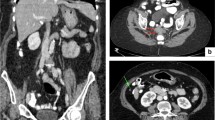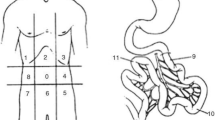Abstract
Ovarian cancer is the seventh most common cancer in females worldwide. Optimal debulking is the standard treatment but possible only in 30–85% of advanced stages. Knowing exactly the disease extent preoperatively may predict suboptimal debulking. We analyzed diagnostic accuracy of preoperative CT scan in disease mapping and prediction of suboptimal debulking in a prospective observational study from March 2013 to May 2015 in a tertiary hospital. Adults below the age of 75 years with ECOG PS-0, 1, 2, clinically/radiologically newly diagnosed stage IIIc epithelial ovarian (EOC), and primary peritoneal carcinoma (PPC) were included. Neoadjuvant chemotherapy recipients were excluded. Preoperative multidetector CT (MDCT) scan showing deposits at 19 predetermined abdominopelvic sites were compared with the same sites seen at laparotomy and corresponding accuracies of CT scan calculated. Primary debulking surgery was done to achieve debulking to nil or less than 1-cm residual disease. Stepwise logistic regression models were used to determine the frequent suboptimal debulking sites and the predictive performance of the clinical and CT scan findings. A total of 36 patients were enrolled. The optimal debulking rate was 50%. The CT scan could detect the disease-bearing sites with overall sensitivity of 68.29%, specificity of 89%, accuracy of 78.07%, and positive and negative predictive values of 99 and 50.1%, respectively. Upon multivariate analysis, bowel mesentery (p 0.011) and omental extension (p 0.025) were associated with suboptimal debulking. CT scan accuracy at these sites (predictive performance) was 86.1%. We identified small bowel mesentery and omental extension (to spleen/stomach/colon) as sites associated with suboptimal debulking. MDCT accurately depicts peritoneal metastases, although sensitivity is reduced in certain areas of significance for optimal debulking. Further validation with more number of patients is warranted.

Similar content being viewed by others
References
Ferlay J, Soerjomataram I Ervik IM et al. (2013). GLOBOCAN 2012 v1.0, cancer incidence and mortality worldwide: IARC CancerBase No. 11 [Internet]. Lyon, France: International Agency for Research on Cancer. Available from http://globocan.iarc.fr date accessed-22/08/2015
Heintz AP, Odicino F, Maisonneuve P et al (2003) Carcinoma of the ovary. Int J Gynaecol Obstet 83(Suppl 1):135–166
Pecorelli S, Favalli G, Zigliani L et al (2003) Cancer in women. Int J Gynaecol Obstet 82:369–379
Armstrong DK, Bundy B, Wenzel L et al (2006) Intraperitoneal cisplatin and paclitaxel in ovarian cancer. N Engl J Med 354:34–43
Ozols RF, Bundy BN, Greer BE et al (2003) Phase III trial of carboplatin and paclitaxel compared with cisplatin and paclitaxel in patients with optimally resected stage III ovarian cancer: a gynecologic oncology group study. J Clin Oncol 21:3194–3200
Shih KK, Chi DS (2010) Maximal cytoreductive effort in epithelial ovarian cancer surgery. J Gynecol Oncol 21:75–80
Chi DS, Eisenhauer EL, Lang J et al (2006) What is the optimal goal of primary cytoreductive surgery for bulky stage IIIC epithelial ovarian carcinoma (EOC)? Gynecol Oncol 103:559–564
Eisenkop SM, Friedman RL, Wang HJ (1998) Complete cytoreductive surgery is feasible and maximizes survival in patients with advanced epithelial ovarian cancer: a prospective study. Gynecol Oncol 69(2):103–108
Bristow RE, Tomacruz RS, Armstrong DK (2002) Survival effect of maximal cytoreductive surgery for advanced ovarian carcinoma during the platinum era: a meta-analysis. J Clin Oncol 20:1248–1259
Aletti GD, Dowdy SC, Gostout BS et al (2006) Aggressive surgical effort and improved survival in advanced-stage ovarian cancer. Obstet Gynecol 107:77–85
Salani R, Zahurak ML, Santillan A (2007) Survival impact of multiple bowel resections in patients undergoing primary cytoreductive surgery for advanced ovarian cancer: a case–control study. Gynecol Oncol 107(3):495–499
Winter WE, Maxwell GL, Tian C et al (2008) Tumor residual after surgical cytoreduction in prediction of clinical outcome in stage IV epithelial ovarian cancer: a Gynecologic Oncology Group Study. J Clin Oncol 26(1):83–89
Winter WE, Maxwell GL, Tian C et al (2007) Prognostic factors for stage III epithelial ovarian cancer: a Gynecologic Oncology Group Study. J Clin Oncol 25:3621–3627
Bristow RE, Duska LR, Lambrou NC et al (2000) A model for predicting surgical outcome in patients with advanced ovarian carcinoma using computed tomography. Cancer 89:1532–1540
Dowdy SC, Mullany SA, Brandt KR et al (2004) The utility of computed tomography scans in predicting suboptimal cytoreductive surgery in women with advanced ovarian carcinoma. Cancer 101:346–352
Qayyum A, Coakley FV, Westphalen AC (2005) Role of CT and MR imaging in predicting optimal cytoreduction of newly diagnosed primary epithelial ovarian cancer. Gynecol Oncol 96:301–306
Suidan RS, Ramirez PT, Sarasohn DM (2014) A multicenter prospective trial evaluating the ability of preoperative computed tomography scan and serum CA-125 to predict suboptimal cytoreduction at primary debulking surgery for advanced ovarian, fallopian tube, and peritoneal cancer. Gynecol Oncol 134(3):455–461
Fagotti A, Ferrandina G, Fanfani F et al (2006) A laparoscopy-based score to predict surgical outcome in patients with advanced ovarian carcinoma: a pilot study. Ann Surg Oncol 13(8):1156–1161
Kang S, Kim T-J, Nam B-H et al (2010) Preoperative serum CA-125 levels and risk of suboptimal cytoreduction in ovarian cancer: a meta-analysis. J Surg Oncol 101:13–17
Tempany CM, Zou KH, Silverman SG et al (2000) Staging of advanced ovarian cancer: comparison of imaging modalities—report from the Radiological Diagnostic Oncology Group. Radiology 215:761–767
Axtell AE, Lee MH, Bristow RE et al (2007) Multi-institutional reciprocal validation study of computed tomography predictors of suboptimal primary cytoreduction in patients with advanced ovarian cancer. J Clin Onco 25(4):384–389
Gemer MG, Ravid M et al (2009) A multicenter validation of computerized tomography models as predictors of non-optimal primary cytoreduction of advanced epithelial ovarian cancer. EJSO 35:1109–1112
Meyers MA (1973) Distribution of intra-abdominal malignant seeding: dependency on dynamics of flow of ascitic fluid. Am J Roentgenol Radium TherNucl Med 119:198–206
Brockbank EC, Ind TE, Barton DP et al (2004) Preoperative predictors of suboptimal primary surgical cytoreduction in women with clinical evidence of advanced primary epithelial ovarian cancer. Int J Gynecol Cancer 14(1):42–50
Goff BA, Mandel LS, Drescher CW et al (2007) Development of an ovarian cancer symptom index: possibilities for earlier detection. Cancer 109(2):221–227
Aletti GD, Gostout BS, Podratz KC et al (2006) Ovarian cancer surgical resectability: relative impact of disease, patient status, and surgeon. Gynecol Oncol 100:33–37
Ferrandina G, Sallustio G, Fagotti A et al (2009) Role of CT scan-based and clinical evaluation in the preoperative prediction of optimal cytoreduction in advanced ovarian cancer: a prospective trial. Br J Cancer 101:1066–1073
Chandrashekhara SH, Thulkar S, Srivastava DN et al (2011) Pre-operative evaluation of peritoneal deposits using multidetector computed tomography in ovarian cancer. Br J Radiol 84:38–43
Ur Metser, Colin Jones, Lindsay M. Jacks et al. (2011). Identification and quantification of peritoneal metastases in patients with ovarian cancer with multidetector computed tomography: correlation with surgery and surgical outcome. Int J Gynecol Cancer;21: 1391–1398
Buy JN, Moss AA, Ghossain MA et al (1988) Peritoneal implants from ovarian tumors: CT findings. Radiology 169(3):691–694
Coakley FV, Choi PH, Gougoutas CA et al (2002) Peritoneal metastases: detection with spiral CT in patients with ovarian cancer. Radiology 223:495–499
Vergote I, Trope CG, Amant F et al (2010) Neoadjuvant chemotherapy or primary surgery in stage IIIC or IV ovarian cancer. N Engl J Med 363(10):943–953
Author information
Authors and Affiliations
Corresponding author
Ethics declarations
All the patients were counseled regarding the nature of the surgery and possible complications. All the patients gave written consent for the study. The study was approved by the ethical committee of the institution.
Conflict of Interest
The authors declare that they have no conflict of interest.
Rights and permissions
About this article
Cite this article
Bagul, K., Vijaykumar, D.K., Rajanbabu, A. et al. Advanced Primary Epithelial Ovarian and Peritoneal Carcinoma—Does Diagnostic Accuracy of Preoperative CT Scan for Detection of Peritoneal Metastatic Sites Reflect into Prediction of Suboptimal Debulking? A Prospective Study. Indian J Surg Oncol 8, 98–104 (2017). https://doi.org/10.1007/s13193-016-0601-6
Received:
Accepted:
Published:
Issue Date:
DOI: https://doi.org/10.1007/s13193-016-0601-6




